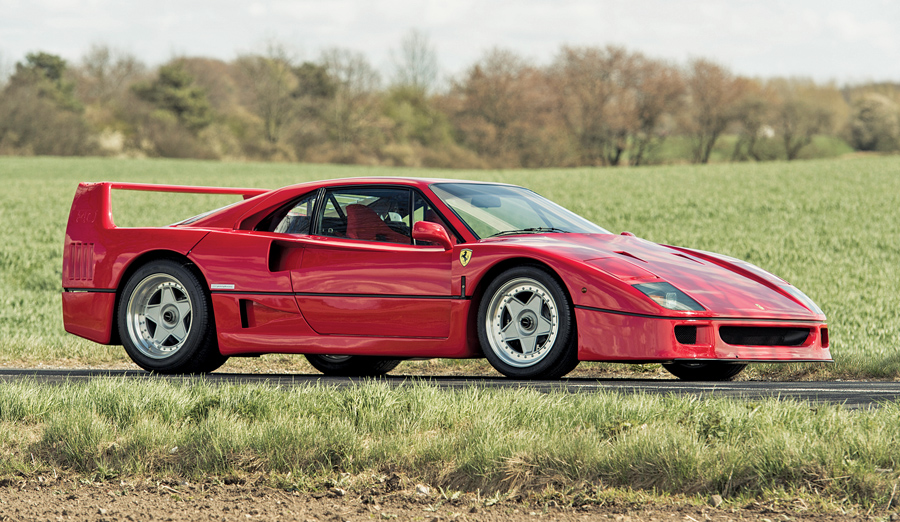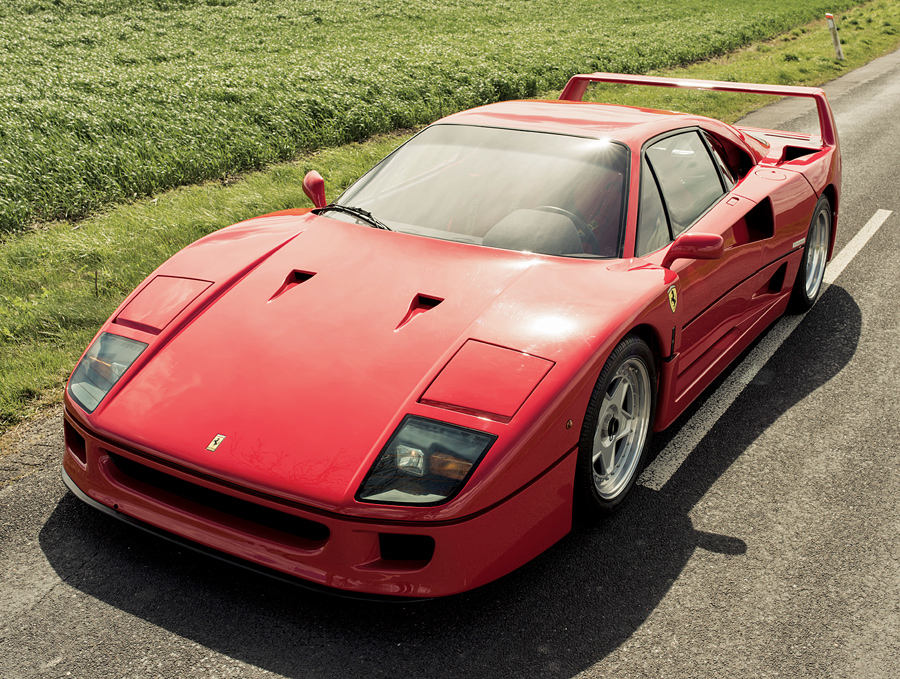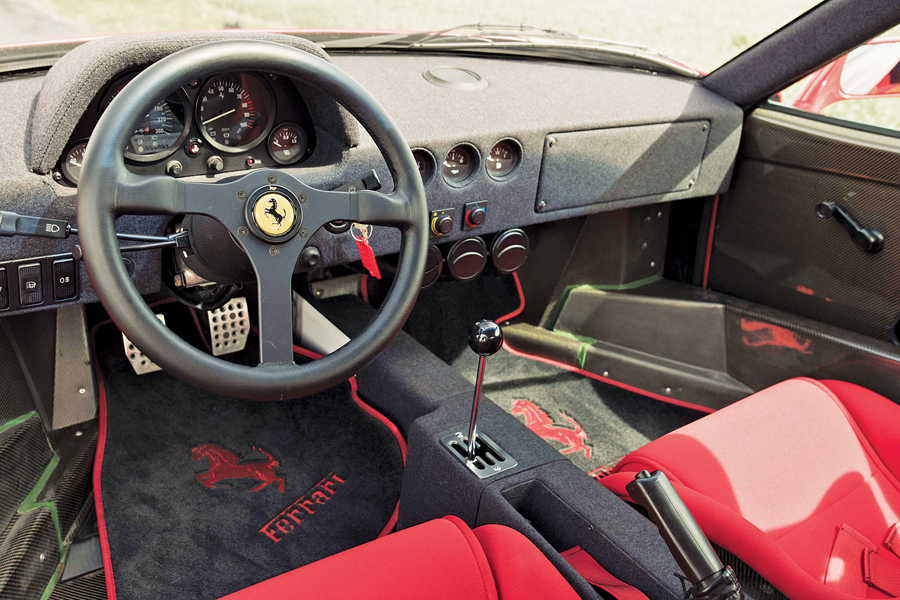“The take-up into the next gear is flawless and with the turbos cranking hard the blast of acceleration just goes on again; you seem to be in a blur of time, conquering distance, gearshifts and noise.”
“It has the tonal quality of an F1 engine, if not the sheer ferocity.”
“On a smooth road it is a scintillatingly fast car that is docile and charming in its nature, demanding but not difficult to drive, blessed with massive grip, and superb balance and manners. You can use its performance — the closest any production carmaker has yet come to race-car levels — and revel in it. ... there’s little doubt it is the very personification of the term ‘sports car.’”
— Autocar magazine, May 1988
This exceptional European-spec F40 was completed in March of 1990. It left the factory void of catalytic converters, fitted with sport seats, adjustable suspension, six-point harnesses, and roll-up glass windows. The F40 was sold new in Japan. It would remain in Japan until being purchased by the consignor in May of 2015.
The car received a $9,000 service at Formula Automobile (Ferrari of Denmark) in 2015 and a fresh major service at Miller Motorcars of Greenwich, CT, in May 2017. A Ferrari Redbook application has also been submitted for Ferrari Classiche certification.
Offered with books, leather pouch, Redbook application, and $30,000 in receipts, which include the extremely recent major service, this superb F40 stands out as one of the absolute best examples to use and enjoy just as Enzo Ferrari intended.
SCM Analysis
Detailing
| Vehicle: | 1990 Ferrari F40 |
| Years Produced: | 1988–91 |
| Number Produced: | 1,311 |
| Original List Price: | $399,100 |
| SCM Valuation: | $1,238,200 |
| Tune Up Cost: | $4,000 |
| Chassis Number Location: | Stamped on the frame in front compartment under washer bottle |
| Engine Number Location: | On top of the engine by the water pump |
| Club Info: | Ferrari Club of America |
| Website: | http://www.FerrariClubofAmerica.org |
| Alternatives: | 1986–88 Porsche 959, 2004–09 Mercedes-Benz SLR McLaren, 1992–95 Bugatti EB110 |
| Investment Grade: | A |
This car, Lot 164, sold for $880,000, including buyer’s premium, at Bonhams’ Greenwich Concours d’Elegance auction in Greenwich, CT, on June 4, 2017.
March 12, 1947, is an important date in Ferrari lore. That is the date that Enzo Ferrari drove his first self-built automobile out the company’s door for a lap around his Maranello neighborhood.
This year is the 70th anniversary of that first drive, and Ferrari’s marketing department is taking full advantage of the occasion.
Ferrari is offering two groups of special-edition models to celebrate the event. One of those groups, The 70 Style Icons, features 70 examples of current Ferrari models decorated in liveries celebrating famous Ferraris race cars and specials. The LaFerrari Aperta is the halo car for the celebration.
The Aperta is the spiritual F70, the third Ferrari supercar built to commemorate an anniversary. The second was the F50 and the original was the F40.
A world-class car
The F40 was introduced with much fanfare in 1987 to commemorate the 40th anniversary of Ferrari. The F40 was based on the GTO Evoluzione, a hard-core competition variation of Ferrari’s first modern supercar — the 288 GTO.
A large wing built into the rear deck announced the F40’s race-car origins.
The seats were racing-style carbon-fiber shells upholstered with fire-retardant red cloth. The wheels were huge, the tires were massive, and a large Lexan window exposed the engine to the world.
The F40 looked like a race car and nearly was one.
The car featured a composite tub with a tubular subframe and composite bodywork.
Power came from a 478-hp, 2.9-liter, twin-turbo V8 engine. The lightweight structure combined with gobs of power made the F40 a world-class performer, but big numbers were only part of the story.
The interior was spartan, with felt-covered dash, no radio, no carpets, and no soundproofing. Doors are opened with a pull cable rather than a lever mechanism. Stones flung off the tires make an audible crack when they hit the composite floor.
The F40 can easily be put into motion by releasing the clutch without touching the throttle. It is so ferocious that under hard acceleration, wheel spin is possible in third gear. There are many faster cars on the market today, but none provides such a raw experience.
Up, down and up again
Buying an F40 is not for the faint of heart. Just when you think you know the market, it changes.
The first U.S. F40s came in at a $389,000 list price. Speculators bid the market price up to over $1,000,000. Unfortunately, the collector car market crashed about the same time.
Within a year, million-dollar cars were selling at half price.
The dip continued. By 2000, F40 prices were as low as $225,000. The next few years saw prices go up and down. Some cars hit $500,000 in 2010 before jumping to over $1 million in 2013.
Today U.S. prices yo-yo between $1,100,000 and $1,500,000, depending on the condition of the car.
More use, lower prices in Europe
European F40 prices trail U.S. cars. Europeans tend to drive their cars more than Americans. Higher mileage equals lower prices.
European cars also had options that turned out to be less desirable over time, such as lightweight sliding Lexan side windows that barely open enough to pay a toll, and adjustable suspensions that become problematic with age.
Our subject F40 was a Japanese-market model. It is a pure European model built without catalytic converters, and it is fitted with racing seats and a six-point harness. Originally delivered with adjustable suspension, it has since been converted to a conventional suspension.
It was offered as complete with owner’s books and tire-inflator bottle. The mileage was a little over 35,000 kilometers — about 21,747 miles.
Until recently, it was nearly impossible to bring a non-U.S.-market F40 into the U.S. The exhaust, fuel tanks and tub structure were so dramatically different between U.S. and non-U.S. market cars that EPA/DOT conversion was impractical. They now qualify for importation under an exemption for 25-year-old cars, so a few are trickling in.
Why not a million bucks?
Million-dollar-car buyers generally are not on a budget. They pay up for quality and heavily discount anything less.
This car was an unknown quantity, as it may be the first Euro import to hit a U.S. auction. It was not a concours queen or a collector-quality specimen. It was a driver-quality car with the mileage a little fat by U.S. standards.
This F40 appears to have traveled from Japan to Holland to the U.S. in search of added value. The car’s legality status was possibly unsettling to some buyers.
This car got clobbered with a price that was less than it should have brought in Japan or Europe. The seller must have decided to throw in the towel rather than spend more money moving the car to a better market.
Anyone seeing the sale price without reading about the car might assume that F40 prices are in trouble. That wasn’t the case here. A U.S. auction was not the ideal venue for the car; as a result, the buyer got a terrific deal. ♦
(Introductory description courtesy of Bonhams.)


